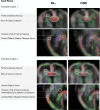This is a preprint.
Deep learning microstructure estimation of developing brains from diffusion MRI: a newborn and fetal study
- PMID: 37425859
- PMCID: PMC10327173
- DOI: 10.1101/2023.07.01.547351
Deep learning microstructure estimation of developing brains from diffusion MRI: a newborn and fetal study
Update in
-
Deep learning microstructure estimation of developing brains from diffusion MRI: A newborn and fetal study.Med Image Anal. 2024 Jul;95:103186. doi: 10.1016/j.media.2024.103186. Epub 2024 Apr 25. Med Image Anal. 2024. PMID: 38701657 Free PMC article.
Abstract
Diffusion-weighted magnetic resonance imaging (dMRI) is widely used to assess the brain white matter. Fiber orientation distribution functions (FODs) are a common way of representing the orientation and density of white matter fibers. However, with standard FOD computation methods, accurate estimation of FODs requires a large number of measurements that usually cannot be acquired for newborns and fetuses. We propose to overcome this limitation by using a deep learning method to map as few as six diffusion-weighted measurements to the target FOD. To train the model, we use the FODs computed using multi-shell high angular resolution measurements as target. Extensive quantitative evaluations show that the new deep learning method, using significantly fewer measurements, achieves comparable or superior results to standard methods such as Constrained Spherical Deconvolution. We demonstrate the generalizability of the new deep learning method across scanners, acquisition protocols, and anatomy on two clinical datasets of newborns and fetuses. Additionally, we compute agreement metrics within the HARDI newborn dataset, and validate fetal FODs with post-mortem histological data. The results of this study show the advantage of deep learning in inferring the microstructure of the developing brain from in-vivo dMRI measurements that are often very limited due to subject motion and limited acquisition times, but also highlight the intrinsic limitations of dMRI in the analysis of the developing brain microstructure. These findings, therefore, advocate for the need for improved methods that are tailored to studying the early development of human brain.
Figures









Similar articles
-
Deep learning microstructure estimation of developing brains from diffusion MRI: A newborn and fetal study.Med Image Anal. 2024 Jul;95:103186. doi: 10.1016/j.media.2024.103186. Epub 2024 Apr 25. Med Image Anal. 2024. PMID: 38701657 Free PMC article.
-
FOD-Net: A deep learning method for fiber orientation distribution angular super resolution.Med Image Anal. 2022 Jul;79:102431. doi: 10.1016/j.media.2022.102431. Epub 2022 Apr 6. Med Image Anal. 2022. PMID: 35397471
-
Enhancing the estimation of fiber orientation distributions using convolutional neural networks.Comput Biol Med. 2021 Aug;135:104643. doi: 10.1016/j.compbiomed.2021.104643. Epub 2021 Jul 14. Comput Biol Med. 2021. PMID: 34280774
-
Generalized Richardson-Lucy (GRL) for analyzing multi-shell diffusion MRI data.Neuroimage. 2020 Sep;218:116948. doi: 10.1016/j.neuroimage.2020.116948. Epub 2020 May 16. Neuroimage. 2020. PMID: 32428705
-
Learning to estimate the fiber orientation distribution function from diffusion-weighted MRI.Neuroimage. 2021 Oct 1;239:118316. doi: 10.1016/j.neuroimage.2021.118316. Epub 2021 Jun 26. Neuroimage. 2021. PMID: 34182101 Free PMC article. Review.
References
Publication types
Grants and funding
LinkOut - more resources
Full Text Sources
